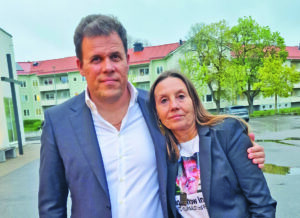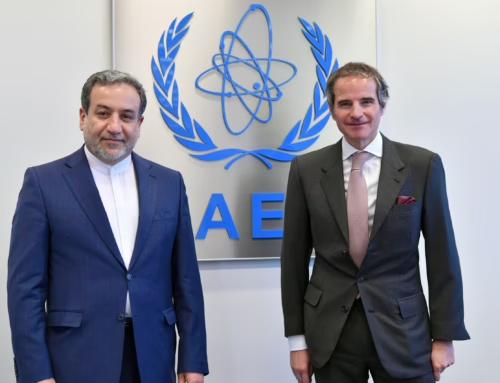Israeli military strategist visits Sweden
Jonathan Conricus, born in Malmö and spokesperson for the Israeli Defense Forces, visited Sweden at the beginning of May, invited by Keren Kayemet (Jewish National Fund) Sweden.
During two well-attended gatherings in Stockholm and Linköping, Conricus laid out the military situation in the Middle East and how Israel’s main enemy, Iran, has changed its strategy for the first time in 25 years.

Visited Sweden: Jonathan Conricus and Rita Lifshitz, whose father-in-law Oded, 84, is being held hostage by the terrorist group Hamas. Photo: Ruben Agnarsson
On the morning of October 7 last year, Jonathan Conricus sat with his family in a shelter in central Israel and watched video clips of the massacre in southern Israel. Already that evening he sat in his first international interview and in the following a few hectic months he became known all over the world via daily interviews in major international media such as CNN, FOX News and BBC.
During his visit to Sweden, he presented a realistic but rather gloomy picture of the war in the Middle East.
– You get more facts if I come here and talk about the military situation on the ground. Much of what happens in Israel and what shapes reality there isn’t seen in Swedish and international media, said the lieutenant colonel and showed Iran to be Israel’s biggest and its major enemy.
– When enemies change their mode of behaviour and you don’t understand why they behave the way they do, you get worried. Both Israel and Iran have recently done things that we have not done since 1979. Iran attacked Israel directly for the first time and Israel has struck back on Iranian soil. Neither Israel nor Iran will back down from this strategy. We are now in a new environment and new things will happen, Conricus explained.
Iran has changed strategy
– For 25-30 years, Iran has strategically and very methodically built proxy organizations with low risk and high effects. Until a few weeks ago, the rules were that Iran attacks Israel through its proxy organizations and that Israel retaliates by attacking those organizations.
– The fact that Iran now reacted as they did means a great risk, but since we don’t know why they did it, I feel a concern. Iran thinks long-term, strategically and is highly disciplined.
The Israeli lieutenant colonel tells how Israel struck a military target that was not so important in itself but lay right next to Iran’s nuclear facilities.
– The message was that Israel can get through Iran’s air defenses. I believe that Israel had intended to strike several locations, but in consultation with the US it became only one target. Israel sent only one percent of the number of missiles Iran launched at Israel. Israel hit the target very effectively. Iran is clearly not immune to Israeli attacks, and we hope that message has gotten across, says Jonathan Conricus.
He believes that as long as Iran has no dilemma supporting proxy organizations for its own security, it will continue with its strategy, which for the Middle East means many more years of war.
– The faster we admit that this is the reality, the faster we will change our strategy.
Allowed to be manipulated
When Conricus visited Sweden, Israeli forces were just preparing to enter Rafah.
– I mean that it is incredibly sad that Israel has allowed itself to be manipulated by Hamas in recent months. When Hamas chose not to complete the first deal, several female hostages were not returned and we understood that Hamas had changed its strategy.
– Unfortunately, through international pressure on Israel, Hamas has succeeded in all its goals. There are hardly any Israeli forces in Gaza, only 5,000 apart from those around Rafah, and humanitarian aid flows in through a number of channels, helping Hamas.
– I have recommended that when we enter Rafah, priority must be given to freeing the hostages. It’s dangerous, Israeli soldiers have been killed in like attempts, but even if the chances of success are slim, this needs to be the focus.
Conricus visited northern Israel a few weeks ago and was able to ascertain that many kibbutzim along the border in the north are deserted.
– It was terrible to see empty, abandoned kibbutzes where Israelis cannot live because Hezbollah uses Russian anti-tank missiles to shoot at the houses. The war will not end until the Israeli civilian population can move back to their homes.
Fighting in Tulkarm
The need is that Hezbollah moves its forces back five, six kilometers from the border.
– When you see what happened on October 7 and realize that there is an even worse enemy on the other side of this northern border, you don’t want to live in a place where you feel exposed and threatened. The problem is that Hezbollah is about five times stronger than Hamas. This applies both to the number of rockets, the explosive power and range of the missiles and the number of soldiers. It’s a completely different military challenge.
Where Israel is at its narrowest, 13 kilometers wide, another conflict is taking place. In Tulkarm, on a level with Netanya, some of the worst battles with an array of Palestinian terrorist groups are now taking place.
– On the other side of that barrier that Israel has built along Route 6, there’s an entirely different universe: terrorist organizations that dream of, and concentrate only on, killing Jews and Israelis. A positive point is that when Hamas via media channels and mosques tried to get all the Palestinians to go out on the streets and kill Israeli soldiers and civilians with knives, cars and guns, the majority of Palestinians in Judea and Samaria stayed at home.
– The Israel Defense Forces (IDF) face a large number and diversity of military challenges like no other military force. We are fighting on four different fronts right now and there are three more that might be opened. We fight on land, at sea, in the air, underground and in cyberspace. We’re fighting five or six different enemies, all of them hooked up to one source. No other defense force in the world meets this challenge.


